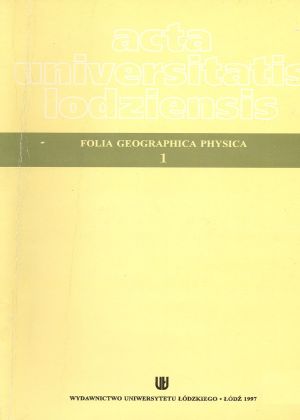Analiza porównawcza składu fizykochemicznego wód opadowych, porowych i gruntowych
Comparative analysis of physicochemical composition of rain, cavity and ground water
Author(s): Janusz BurchardSubject(s): Environmental Geography
Published by: Wydawnictwo Uniwersytetu Łódzkiego
Keywords: rain; cavity water;ground water;
Summary/Abstract: Physicochemical composition of rain, cavity and ground water is presented in this paper. Cavity water (solutions) was extracted with the use of the pressure method from clayey-sandyand sandy deposits taken from the Łódż region (Rypułtowice) and the Bełchatów region (Kałduny) - Fig. 1.The highest total mineralization was characteristic of cavity water. The lowest mineralization was typical of rain water. Averager proportions of mineralization of rain, ground and cavity water account for l : 20 : 35 (Rypułtowice) and l : 13 : 20 (Kałduny). Maximal total mineralization of cavity water reached 1059 mg . dm-J (till) and 1244 mg . dm-J (sandy soil), whereas mineralization of rain water was about 36-38 -mg· dm-J.The reaction of rain water was acidic and its pH was found to be 3,9--4,1. The top ground layer which contains some carbonates acts as a buffer that changes the reaction of infIltrating rain water to neutral or slightly alcaline. Cavity water pH was between 6,4-8,4 and ground water pH was 7,1-7,8.Rain water was triionic of the HCO) - SO. - Ca type and ground water was tri- and tetraionic of the HCO) - SO. - Ca (Rypułtowice) and the HCO) - SO. - Ca - K type (Kałduny), respectively. The most complex composition was characteristic of cavity water (tetra- and pentaionic water) which represented two hydrochemical types: Cl - SO. - Ca – Mg (Rypułtowice) and HCO) - SO. - Cl - Ca - Mg (Kałduny). HC01-, SOl-, Ca2+ predominated in all types of water, whereas other ions, such as CI-, K + and Mg 2+ modyfied considerably the water composition and hydrochemical type (Tabs 3-5). Unnaturally large amounts of SO.2-, CI- and K+ in the ground water were assumed to be associated with antropogenic pollution, mainly from areał and point sources (e.g. from cesspit leakage in Kałduny). It is interesting to observe the distribution of nitrates in cavity water. In Rypułtowice a one meter thick till layer causes the decrease in a very high NO)- concentration of 595 mg . dm-l below the top of the impermeable till (Fig. 2). The till layer acts as a barrier which hinders migration of the pollution from the ground surface. The concentration of nitrates in the sandy soil in Kałduny was different, and varied with a depth, with the tendency decrease, in a way that gave an image of a wave of NO)- moving downwards (Fig. 3). Due to the lack of an isolating layer, the pollution was able to migrate freely to ground water.
Journal: Acta Universitatis Lodziensis. Folia Geographica Physica
- Issue Year: 1/1997
- Issue No: 1
- Page Range: 109-125
- Page Count: 17
- Language: Polish

